Gliding together in a rippling curtain of color, a school of discus is a sight to behold.
With its unique flat, circular body and brilliant patterns, it’s easy to see how this fish earned the title of “King of the Aquarium.”
Discus fall into the cichlid family, genus Symphysodon, and thrive in the warm waters of their native Amazon habitat.
They are a peaceful schooling species that grows to an adult length of 8 to 10 inches (20-25 cm).
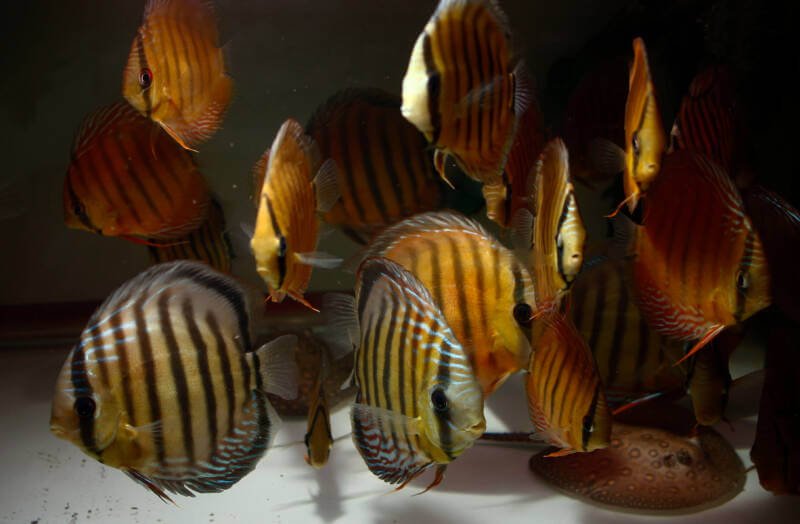
In a home aquarium setting, they require a significant tank size of three feet in length (90 cm) and 18 inches tall (45 cm), around 55 – 75 gallons altogether (200-280 l).
This smart and active fish shows off its best colors and behaviors when kept in a group of at least six.
They favor the middle to upper levels of the water column and often react to their owner’s presence.
In this article
Discus Compatibility
Water Parameters
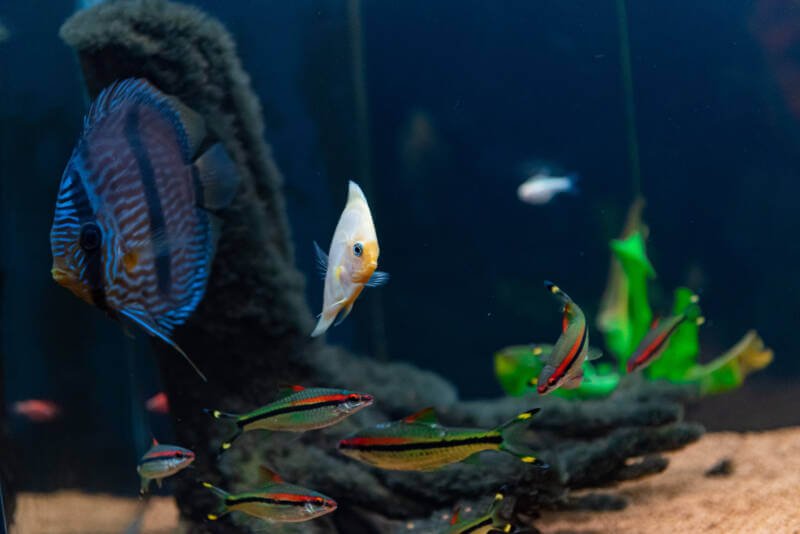
Discus need a higher water temperature than most, in the range of 80 to 85°F (27-29°C), with a pH level between 6 and 7 and a hardness around 2 dKH.
As a result, fish from the same part of the world are the easiest choice as they live in similar conditions.
While species from other regions can survive in these higher temperatures, the environmental conditions may shorten their lifespan. Overall, there are plenty of compatible species.
Other Compatibility Factors
In addition to environmental compatibility, look for the following when seeking a tank mate for your discus:
- Similarly sized, calm natured fish
- Schooling or dither fish, which help your discus feel secure
- Peaceful bottom feeders that occupy a different level of the water column.
Avoid the following:
- Overactive, fast-swimming fish
- Large, aggressive fish
- Brackish water fish.
Recommended Discus Tank Mates
The following species have the best odds of pairing well with your discus.
1. German Ram (Mikrogeophagus ramirezi)

Minimum Tank Size: 20 gallons
The German ram comes from slow-moving streams in the northern part of South America.
This smaller cichlid reaches an adult length of two to three inches (5-7.6 cm). It has an inquisitive nature and pairs well with other peaceful species.
This fish can be kept as a single specimen or in a pair. Keep no more than two German rams in the same tank to limit territorial behavior and double the tank size if keeping two.
Rams enjoy swimming in the open but need plenty of hiding spaces among the plants to make them feel comfortable.
2. Kuhli Loach (Pangio kuhlii)
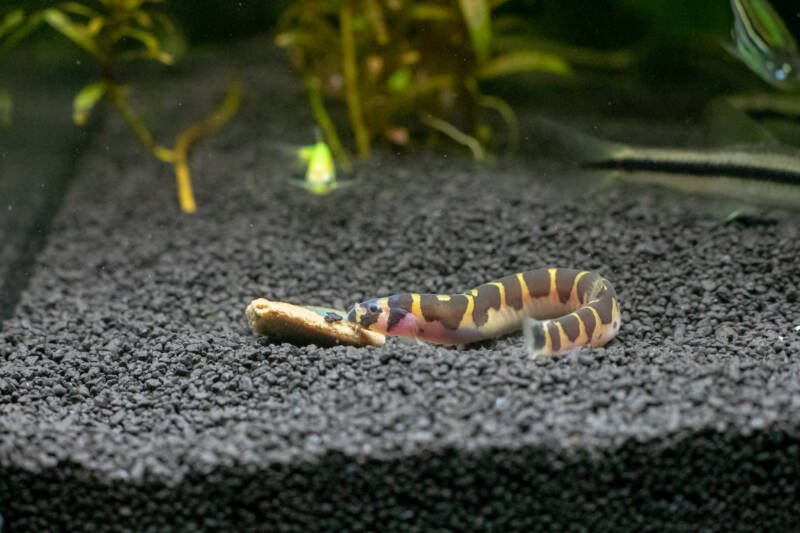
Minimum Tank Size: 15 gallons
The eel-shaped kuhli loach brings a unique look to your discus tank.
Hailing from the rivers of Southeast Asia, they can reach anywhere between three to five inches in length (7-13 cm) but typically stay on the shorter side.
They are bottom-dwelling scavengers that stick to that level.
Kuhlis can be shy as a rule and even more so when kept as a single specimen.
They keep to their hiding spaces during the day and are more active at night, which allows them to be active when the discus is at rest and vice versa.
These fish are more susceptible to disease due to their thin scales. Keep the water clean to significantly reduce the chance of illness.
3. Bolivian Ram (Mikrogeophagus altispinosus)

Minimum Tank Size: 30 gallons
The Bolivian ram can be found in the shallow, slow-moving waters of Bolivia and Brazil.
Reaching an adult size of around three inches (7 cm), the ram has a calm personality for a cichlid, and that behavior is reinforced when they are kept in a small group of at least six.
As with your discus, the Bolivian ram loves a well-planted tank with plenty of swimming space. Rams usually stay in the middle to bottom areas.
The discus and Bolivian ram should not come into conflict over bottom hiding areas, especially if the ram is kept comfortable in a group of its own kind.
4. Sterbai Cory (Corydoras Sterbai)
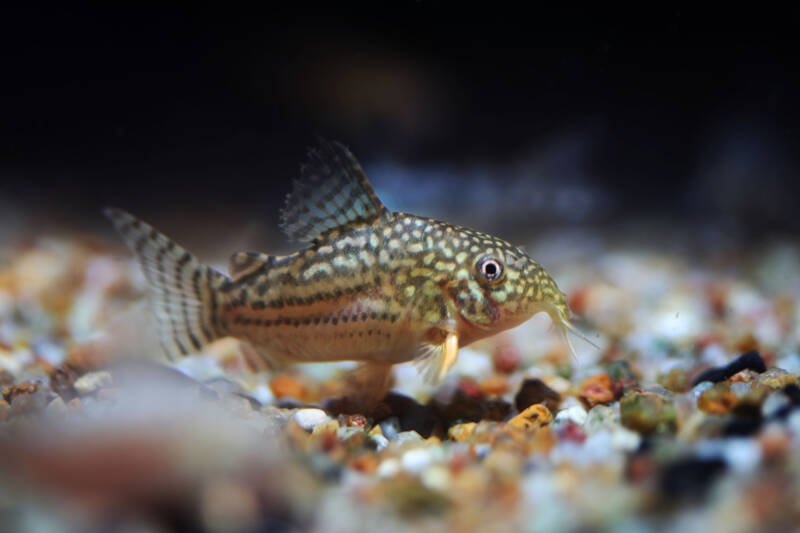
Minimum Tank Size: 20 gallons for 4 corys
There are several great options in the cory catfish family, but one of the best is the sterbai.
This South American resident of fast-flowing streams has a gentle personality and spends its time scavenging along the tank bottom.
They are one of few cory species that come from the same area as the discus and therefore thrive in warmer waters.
Sterbais grow to about 2.5 inches (6 cm) in length and have a long lifespan of 15 to 20 years!
They are best kept in a group of four to six, which will help them feel secure and be more active.
These fish will not compete with your discus at feeding time as they eat just before dusk.
5. Tetras (Characidae)

Minimum Tank Size: 20 to 30 gallons
Tetras are an excellent and popular choice to pair with discus. The benefit of these fish is their passive schooling behavior.
These “dither fish” bring a sense of calm to a tank simply by swimming in the open water. Other fish see this and take it as a cue that no predators are around, which helps reduce aggression.
Select a species that grows large enough that it will not be considered food by your discus.
You can try lemons, Congo, cardinals, neons, rummy noses, emperors, or Buenos Aires tetras.
Introduce a good-sized school for the best effect.
6. Apistogramma (genus)
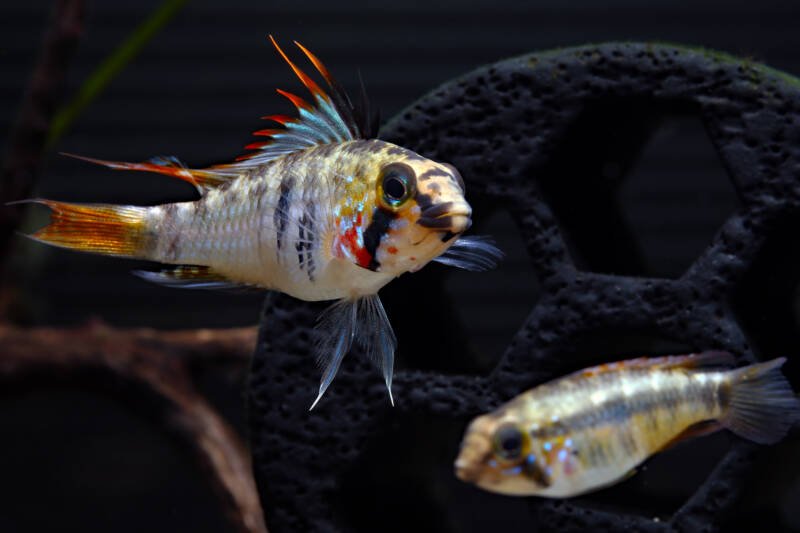
Minimum Tank Size: 20 gallons
Apistogramma is the genus name for a group of over 90 cichlid species.
These “dwarf” cichlids come from various locations in South America with adult sizes ranging from 0.8 to 3.1 inches in length (2-8 cm).
They sport a variety of colors, with the males generally more vividly colored. Apistos love the same warm waters as the discus and make excellent tank mates.
These fish can be territorial, so ensure multiple hiding spaces. They can be kept as bonded pairs or a single male with multiple females.
Because they stay near the bottom of the tank and close by hiding spaces, they will keep out of the way of your discus.
7. Siamese Algae Eater (Crossocheilus oblongus)

Minimum Tank Size: 20 gallons
The Siamese algae eater is highly efficient and very active, patrolling the tank bottom regularly.
They come from the rivers of Southeast Asia and reach an adult length of six inches (15 cm).
Be careful not to overstock this fish as they produce a fair amount of waste, which can negatively impact your water quality.
These are excellent tank mates for your discus because they occupy the tank bottom and eat algae; therefore, they will not compete with your discus for territory or food.
When you first introduce them to the tank, watch that their activity level does not upset the discus.
8. Malaysian Trumpet Snail / MTS (Melanoides tuberculata)
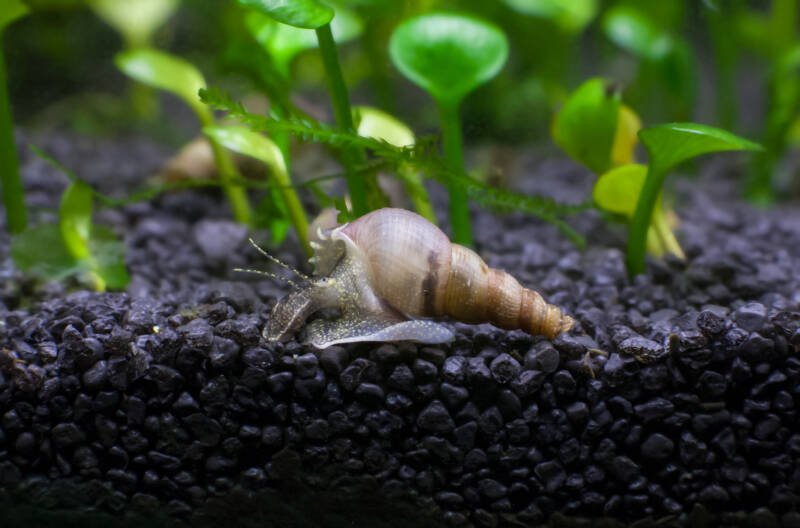
Minimum Tank Size: 5 gallons
The MTS eats algae and detritus, even burrowing into the substrate to get at food.
A helpful part of a tank cleanup crew, their burrowing also aerates the substrate and prevents the buildup of hazardous gasses.
They are a small species, reaching an adult length of 0.25 to 0.5 inches (0.6-1.2 cm), and have an operculum, or trap door, which helps protect them from predators.
The MTS pair well with the discus because they occupy a different water level and thrive on the same light flow water conditions.
Be careful to not overstock them. Doing so creates a heavy impact on the bioload and can lead to increased nitrate and ammonia.
9. Amano Shrimp (Caridina multidentata)
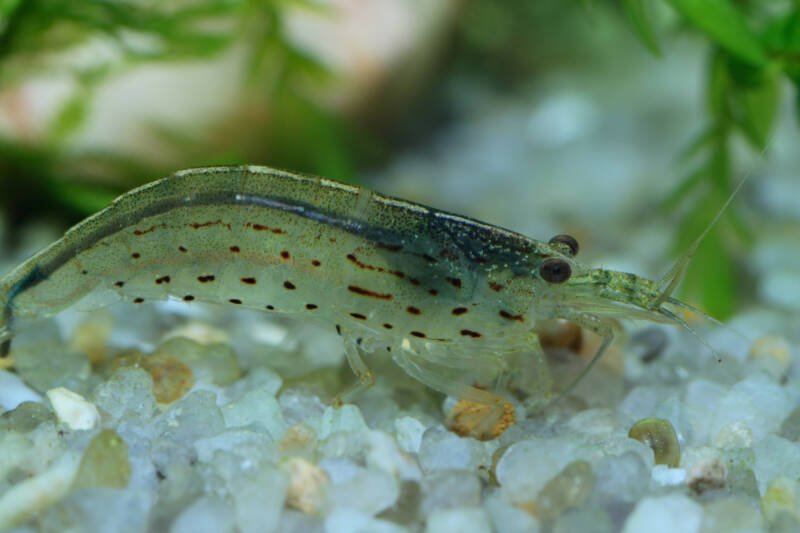
Minimum Tank Size: 10 gallons
The Amano shrimp is a small, transparent species native to Asia.
It is one of the larger “dwarf” shrimp species, reaching an adult length of up to two inches (5 cm).
These peaceful and active omnivores are extremely popular for home aquariums and an important part of a tank cleanup crew, readily consuming leftover food and nuisance algae.
The discus occupies different levels of the water column and should not bother your busy shrimp.
Because the Amano has a little method of self-defense, they are best in a heavily planted tank with plenty of hiding places to give them protection as they molt.
10. Harlequin Rasboras (Trigonostigma heteromorpha)
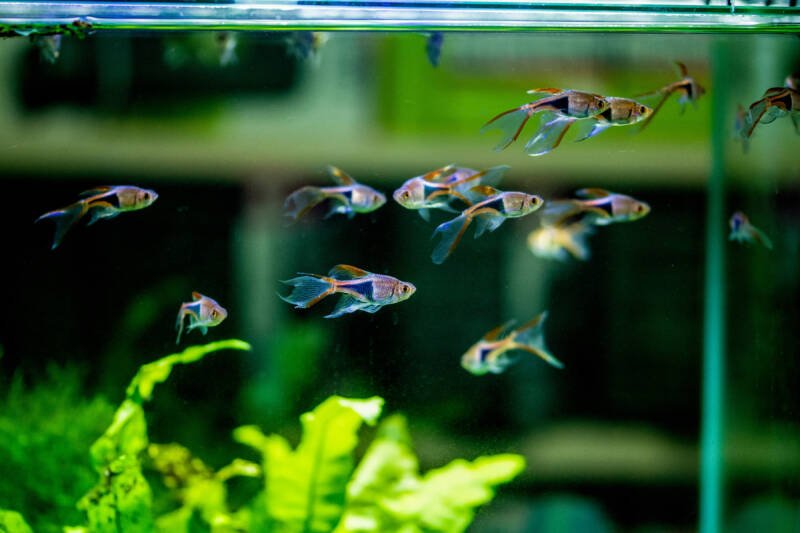
Minimum Tank Size: 10 gallons
The harlequin rasbora is an immensely popular aquarium addition with unmistakable markings.
This schooling fish originated in Southeast Asia. It is hardy, easy to care for, and reaches an adult length of around two inches (5 cm).
When pairing harlequin rasboras with discus, keep the water temperature toward the lower end of the discus’ range.
Rasboras in a good-sized school are excellent dither fish to help calm the tank. Make sure there is plenty of swimming space as the rasboras and discus will occupy the same water levels.
Live plants will provide hiding spaces for the rasboras as needed.
11. Fancy Plecos (Loricariidae)
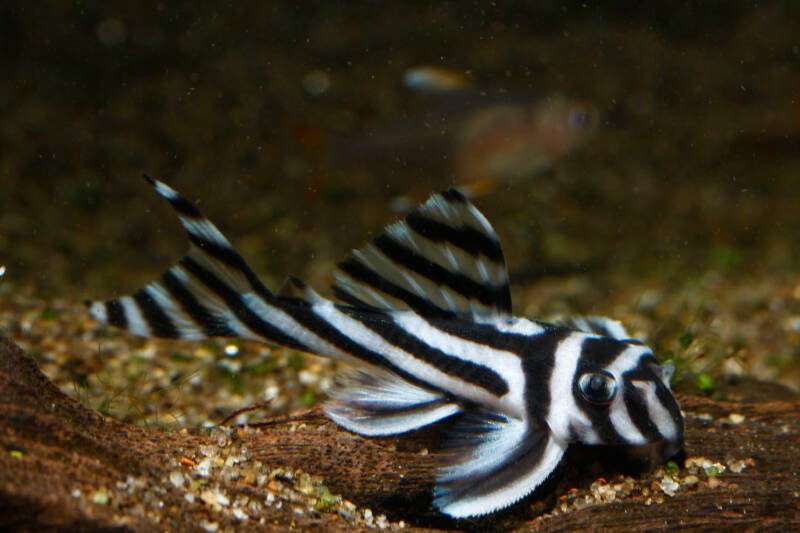
Minimum Tank Size: 10 to 30 gallons, depending on the species
There are 400 types of fancy plecos, each one designated with an “L-“ number indicating their residence in the Loricariidae family of armored catfish.
These plecos grow between 4-6 inches (10-15 cm) in length and bring stunning colors and patterns to your tank.
Plecos are peaceful bottom dwellers that get along with almost any other species. With fancy plecos, research beforehand to determine their compatibility.
Some, like the zebra pleco, enjoy the same warm waters as the discus, while others prefer cooler waters and fast-moving currents.
Some can be kept as a single specimen while others require a small group to feel comfortable.
12. Clown Loach (Chromobotia macracanthus)
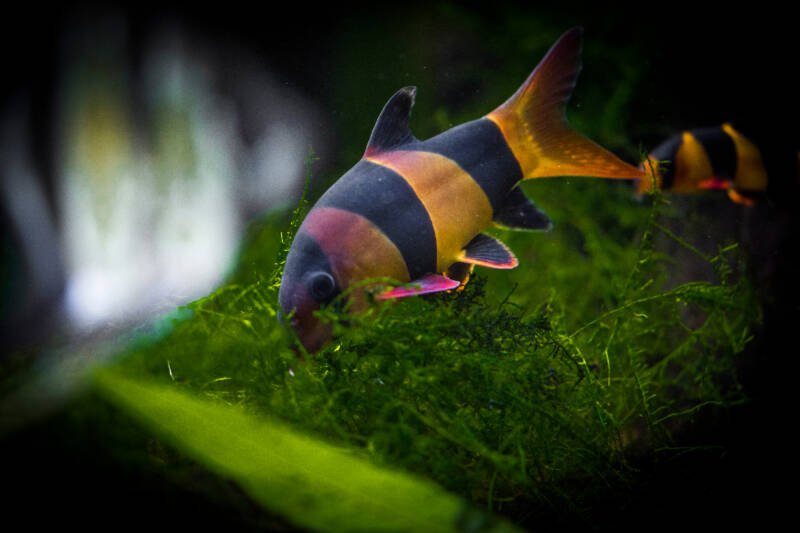
Minimum Tank Size: 100 gallons for three to five fish
The peaceful clown loach is a colorful fish that enjoys searching for food along the tank bottom.
They reach a large adult size close to 12 inches in length (30 cm).
Combine this with the fact that they are schooling fish that are comfortable in a group of three or more, and you are looking at a significant tank size.
These fish are active when kept in a group but can sometimes be shy and need a place to hide.
They love the same water conditions as the discus and are quite compatible because they occupy the bottom of the water column.
Keep an eye on activity levels to ensure the group is not too busy for your discus.
13. Yo-yo Loach (Botia almorhae)
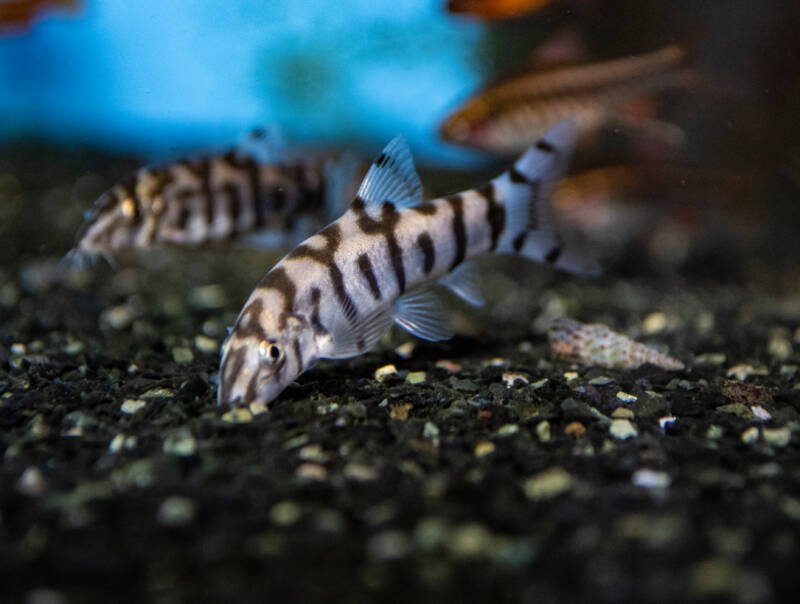
Minimum Tank Size: 40 gallons
The yo-yo loach hails from northern India and Nepal. They come in silver, blue, and gold hues with an intricate pattern covering their body.
Although these smaller fish reach only 2.5 inches in length (6 cm), they need a significant amount of space for them to be healthy.
In addition, they are best kept in a group of four to five, so adjust tank sizes accordingly.
These energetic fish have a higher activity level than other loaches, even during the day. Observe the interaction between the loach and discus.
Loaches can be curious and depending on the individual temperament of your discus, that activity level may be too much.
Introduce with Caution
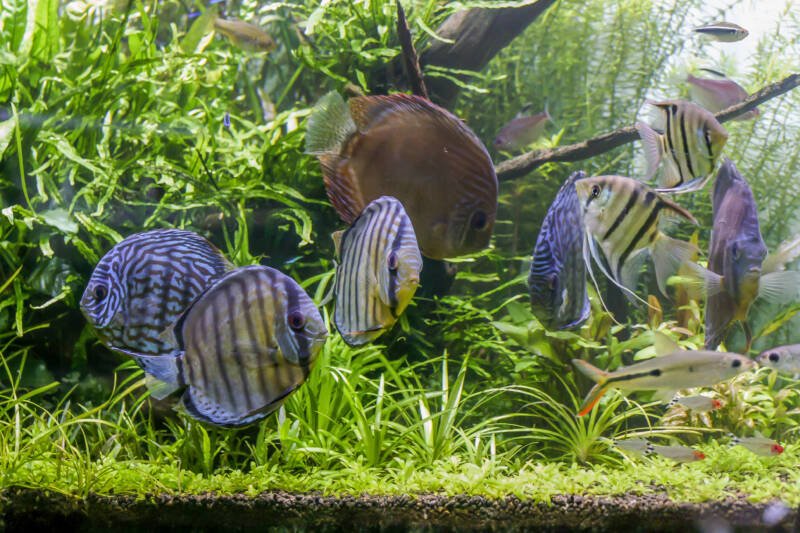
The following species are more active or aggressive but can pair well with your discus if care is taken.
14. Oscar (Astronotus ocellatus)
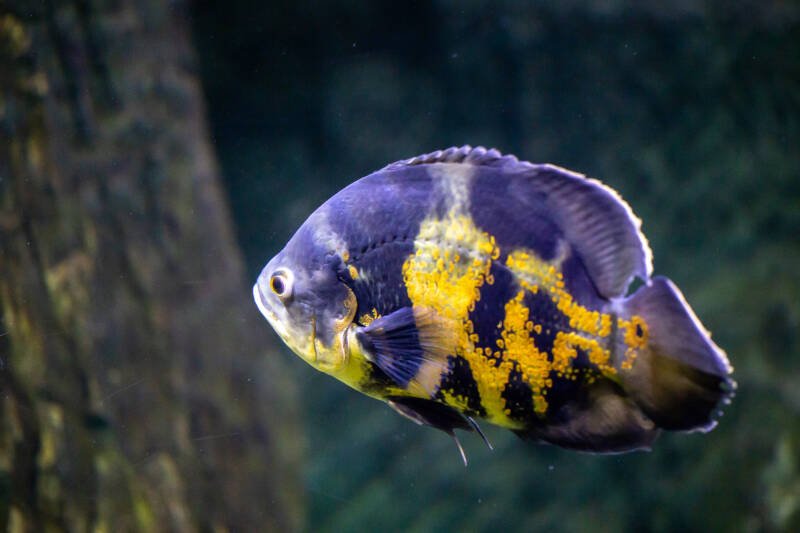
Minimum Tank Size: 55 gallons for a single fish
There are several challenges in pairing an oscar with a discus.
The first is behavior. Oscars can be aggressive and territorial, in contrast to the discus’ more peaceful nature.
These fish occupy the same water column levels, and the oscar’s bigger size of 12 inches (30 cm) may lead to conflict.
Their water requirements also differ slightly. If you pair these fish, keep the temperature at the lower end of the discus’ range and the higher of the oscar’s.
The oscar prefers harder water to the discus’ soft.
The two species can live together if the tank is large, the discus have a decent-sized school, and the oscar is introduced last as a young, single specimen.
Monitor the fish for any aggressive interactions.
15. Silver Arowana (Osteoglossum bicirrhosum)
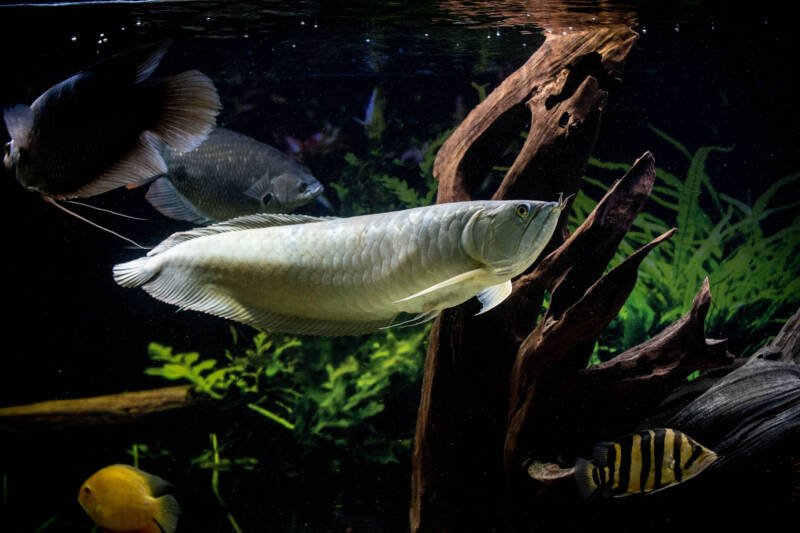
Minimum Tank Size: 250 gallons
The silver arowana is a large, South American fish. They have a unique, upturned mouth and fins that traverse the body toward an undersized tail.
The discus and arowana are both from the same region and favor identical water parameters.
The arowana is a highly aggressive predator that reaches three feet (91 cm) in length when fully grown.
They have a fast growth rate and keeping them in an undersized tank can lead to aggression and developmental issues.
Due to the arowana’s predatory nature, introduce them last to an established discus tank and make sure the arowana is very young.
As with any aggressive fish, monitor interactions and be prepared to separate them as needed.
16. Roseline Sharks (Sahyadria denisonii)
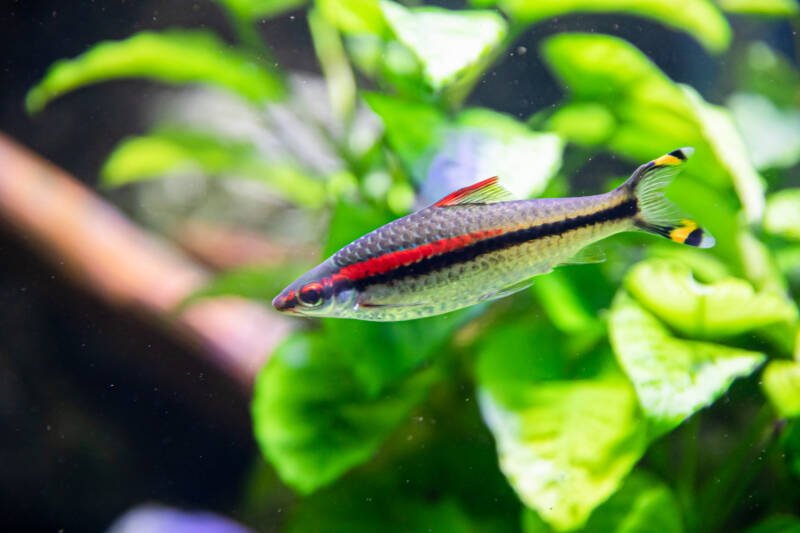
Minimum Tank Size: 55 gallons for a small group
Roseline sharks are also called denison barbs.
These active fish come from fast-moving rivers in western India, and they bring a splash of vibrant color and plenty of movement to an aquarium.
They reach an adult length of six inches (15 cm). This size makes them compatible with the discus provided you have an appropriately sized tank with plenty of swimming space. They do best in a group of at least six.
Roselines prefer slightly cooler and more turbulent waters and are fast swimmers, which may annoy your discus.
Introducing the roseline group when they are small and ensuring a large tank size may allow for better acclimation between the species.
17. Angelfish (Pterophyllum scalare)
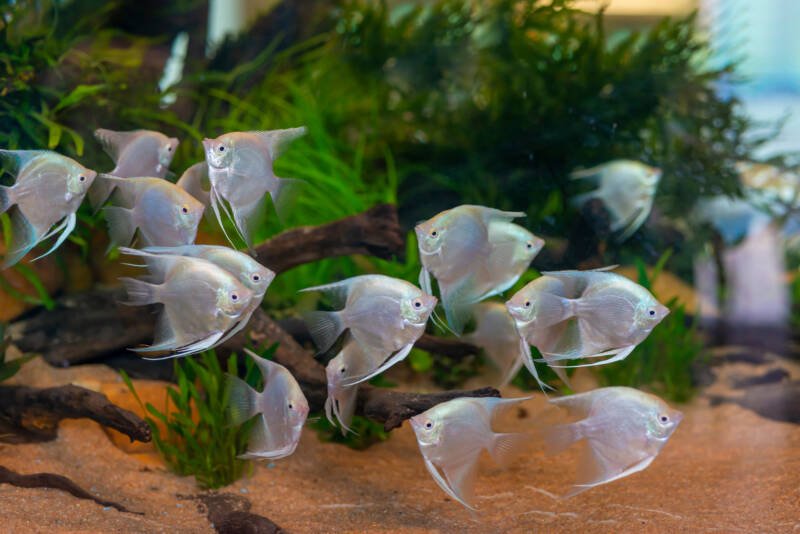
Minimum Tank Size: 80 gallons for a small school
Angelfish come from the same area as the discus and enjoy similar, but not identical water conditions.
There are areas where the conditions overlap, so cycle your tank before adding your fish and set the water is in those zones.
This freshwater cichlid is easy-to-care-for schooling fish.
Angels grow up to six inches in length (15 cm) and come in a variety of color forms.
While they have a reputation for aggression, it is usually confined to the school and does not extend to others in an aquarium.
Although with cichlids, that is always something to keep an eye on. Introducing the discus to the tank second may help the fish to acclimate.
Closing Thoughts
Putting together a discus tank takes planning, preparation, and a little bit of research.
However, the final sight of these lovely fish and their tank mates exploring their surroundings will be worth the work!
When selecting a tank mate, pay attention to the fish’s behavior, adult size, and water parameter requirements.
Water requirements are the first limiting factor, as many freshwater species either cannot survive or will not thrive in the warm waters loved by the discus.
Some species may be close in requirements but keeping fish at the extremes of their tolerance range is never optimal for their health.
The intended tank mate’s adult size comes into play next, as that will dictate what tank you need to accommodate them.
Finally, note the typical behaviors of the species and remember that these are trends in that breed’s behavior. Ultimately, compatibility comes down to the personality of the individual fish.
Keep an eye on interactions and be prepared to rearrange things until you reach a peaceful equilibrium.
Give us a shout below!
Do you keep your discus fish as a single species or in a community tank?